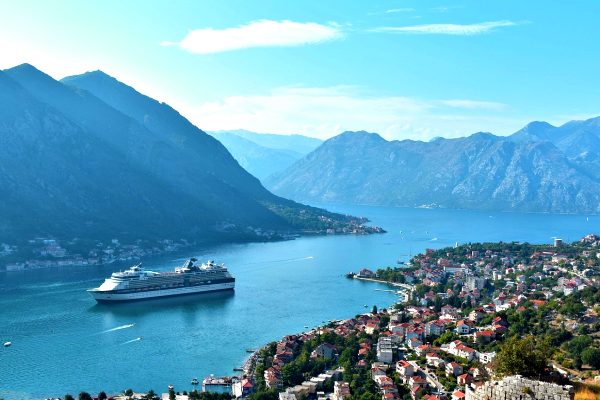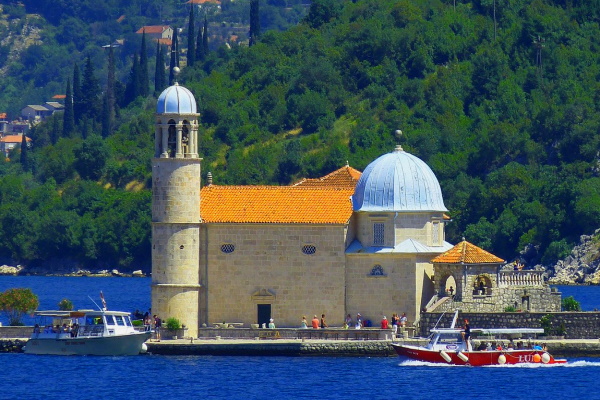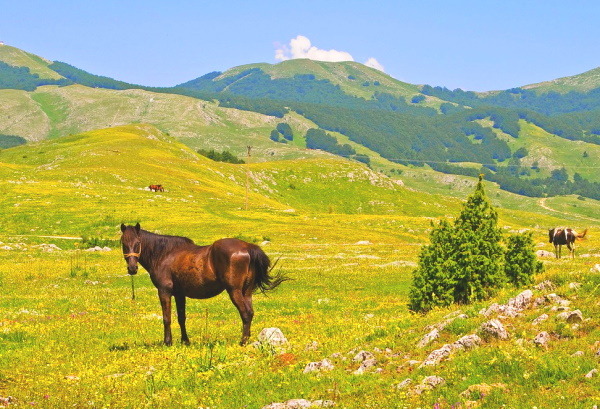Due to its proximity, getting from Croatia to Montenegro is quite straightforward. The last time we entered Montenegro from Croatia on the Adriatic coast, the waiting time at the border was quite long. About an hour, as the processing of the vehicles was very slow. This was in April 2024, the question remains whether it will take longer due to higher traffic volumes in the high season.
Here’s a quick guide for traveling between the two countries:
By car:
If you are traveling by car, there are several border crossings between Croatia and Montenegro.
The move from Herceg Novi in Montenegro to Dubrovnik in Croatia certainly attracts the most tourists.
Day tours in Montenegro by bus or boat can be booked using this link
Make sure you have the necessary vehicle documents and passport.
Tolls: Tolls may apply on roads.
Therefore, make sure you have local currency or a credit card.
Insurance: Make sure your car insurance in Montenegro is valid.
Sometimes additional insurance is required at the border.
Travel time: From Dubrovnik to Kotor in Montenegro, the journey takes 1.5 to 2 hours, depending on traffic and waiting times at the border.

By bus:
There are regular bus routes between major cities in Croatia (such as Dubrovnik, Split) and destinations in Montenegro (such as Kotor, Budva and Podgorica).
Duration: The bus journey from Dubrovnik to Kotor usually takes 2 to 3 hours, but this time may vary depending on stops and waiting times at the border.
Tickets: Tickets should be booked in advance, especially during tourist season.
Great day tour to the small country of Montenegro from Dubrovnik: More information and booking on this link
On the boat:
If you’re on the coast, there are a number of boats and ferries that travel between the cities of Croatia (like Dubrovnik) and the coastal towns of Montenegro (like Kotor and Budva).
By plane:
Although both Croatia and Montenegro have international airports, flights may not be the most efficient due to the short distances unless you are traveling from a remote part of Croatia such as Zagreb to Podgorica.
Important instructions:
Passport and visa: Croatia is a member of the EU, Montenegro is not.
Even if you don’t need a visa for any country due to your nationality, you still need to show your passport at the border.
Always check the visa requirements before you travel.
Seasons: Both countries are popular travel destinations, especially in the summer months.
Be prepared for possible delays and heavy crowds from June to August.
Bon Voyage! Both Croatia and Montenegro offer breathtaking sea views, historic sites and delicious cuisine.
Great day tour to the small country of Montenegro from Dubrovnik: More information and booking on this link
Sights of Montenegro
Often referred to as the “Pearl of the Mediterranean,” Montenegro is a country of breathtaking natural beauty and rich history.
Here are some must-see attractions in Montenegro:
Bay of Kotor (Boka Kotorska): This UNESCO World Heritage Site is often referred to as Europe’s southernmost fjord.
The bay is surrounded by mountains and charming medieval towns are scattered along the coast. Kotor, a walled city famous for its historic buildings, squares and St. Tryphon.
Lovcen National Park This is Mount Lovcen. This park offers panoramic views of the entire country from the mausoleum of Pyotr Petrovich Negosh, perched on one of its peaks.
Stary Bar: An ancient walled city on a hill with picturesque ruins and views of the Adriatic Sea.
Sveti Stefan: Once a fishing village, this tiny island is now a luxury resort connected to the mainland by a narrow road.
Ostrog Monastery: A beautiful monastery perched on a rock that appears to be carved into the vertical face of the mountain. It is one of the most important pilgrimage sites in the Balkans.
Lake Skadar National Park: One of the largest lakes in Europe, this lake offers stunning scenery, rich bird life and historical sites. Boating is a popular way to explore the lake.
Durmitor National Park: A UNESCO World Heritage Site, this park offers stunning mountain scenery, dense pine forests and Europe’s deepest gorge, the Tara Gorge. It’s a great place for hiking, rafting and winter sports.
Biogradska Gora National Park: one of the oldest and largest primary forests in Europe. There is also a beautiful glacial lake Biograd in the park.
Cetinje: Cetinje, the historic capital of Montenegro, offers a glimpse into the country’s royal past with museums, old embassies and the old royal palace.


Great day tour to the small country of Montenegro from Dubrovnik: More information and booking on this link
Facts about Montenegro for visitors
Montenegro is located in southeastern Europe on the Balkan Peninsula.
It has a coastline along the Adriatic Sea and borders Croatia, Bosnia and Herzegovina, Serbia, Kosovo and Albania.
The capital is Podgorica.
Other large cities are Niksic, Bar and Kotor.
The official language is Montenegrin.
However, some parts of the population also speak Serbian, Bosnian, Albanian and Croatian.
English is widely spoken in tourist areas and by the younger generation.
Montenegro uses the Euro (€) as its official currency, although it is not a member of the European Union.
The coastal regions have a Mediterranean climate with hot summers and mild winters.
Inland, especially in the northern mountains, the climate is continental, with cold winters and mild summers.
Montenegro is nicknamed the “Pearl of the Mediterranean” due to its pristine coastline.
There are two UNESCO World Heritage Sites in the country: the Bay of Kotor and Durmitor National Park.
The main international airport is located in Podgorica and another major airport is located in Tivat.
Montenegro’s rail system connects major cities such as Podgorica, Bar and Niksic.
Montenegro has a rich history influenced by the Roman, Byzantine, Ottoman and Austro-Hungarian Empires.
The culture combines Slavic, Mediterranean and Muslim influences.
Most Montenegrins identify as Orthodox Christians.
There are also significant communities of Muslims, Catholics and other religious groups.
Day tours in Montenegro by bus or boat can be booked using this link
Montenegrin cuisine is characterized by Mediterranean and Slavic influences.
Seafood, olives, cheese, dried meat and various baked goods are popular.
Popular alcoholic drinks include rakia (fruit brandies) and local wines.
Traffic is on the right side of the street.
The coastal path offers spectacular views but can be winding and narrow at times.
Driving carefully is very important.
Montenegro is generally considered safe for tourists.
However, as with anything, it is very important to be aware of your surroundings and to be on the lookout at all times.
It is customary to greet people with a handshake.
If you are invited to someone’s home, politely bring a small gift.
Central European Time (CET) and summer time apply in Montenegro.
Coast of Montenegro
Stretching some 293 kilometers along the Adriatic Sea, Montenegro’s coastline is known for its splendor, walled old towns, pristine beaches and breathtaking bay views.
Here is a summary of some of the sights of the Montenegrin coast:
Herceg Novi: This is the first big city you will encounter when you come to Montenegro from Croatia.
Known for its forts, rich history and known as the “City of Flowers” thanks to its many lush gardens and plantations.
Bay of Kotor (Boka Kotor): Often compared to a fjord, this winding bay is surrounded by high mountains and medieval towns along the coast.
Kotor: Kotor is a UNESCO World Heritage Site and is known for its well-preserved medieval old town, city walls and breathtaking views from the Fortress of San Giovanni.
Perast: A charming town known for its baroque palaces and churches as well as two small islands, Our Lady of the Rock and St. George.
Tivat: Located in the Bay of Kotor, it is known for its luxurious port of Porto Montenegro, which is often compared to Monaco for its high-quality yachts and services.
Budva: Budva is one of the oldest cities on the Adriatic and famous for its vibrant nightlife, sandy beaches, narrow streets of the old town and the walls of Venice.
Nearby is the famous island of Sveti Stefan, now a luxury resort.
Petrovac: A small coastal town with Venetian fortresses, beautiful promenades and sandy beaches.
Sutomore: known for its long sandy beach, popular with sunbathers.
Bar: This city is a mix of modernity and history. While the modern part of the Bar is the main port, the old part, the Old Bar, lies inland on a hill and offers ruins and breathtaking views.
Ulcinj: The southernmost coastal town of Ulcinj is famous for its long sandy beaches such as Velika Plaža (Big Beach) and the old town, which is rich in history and shows traces of Illyrian, Roman and Ottoman influences.
Also nearby is Ada Bojana, a unique river island with long sandy beaches and a popular kitesurfing spot.
In addition to cities, there are many bays, beaches and coves on the coast of Montenegro.
Some beaches are sandy, others rocky or pebbly, but most have crystal clear Adriatic water.
Great day tour to the small country of Montenegro from Dubrovnik: More information and booking on this link
The capital Podgorica
Podgorica, the capital of Montenegro, may not have the medieval charm of some of its coastal towns, but is undoubtedly the bustling hub of modern Montenegrin life.
Often a tourist destination due to its airport and convenient transportation options, Podgorica offers more than just transit services.
is a place full of history, modern architecture, filled with nightlife and lush greenery.
Here is a guide for tourists visiting this vibrant city:
1. Historical Heritage:
Old Varos: This “old town” area is a testament to the Ottoman period with its stone houses, narrow streets and the famous clock tower.
Duklja Ruins: Built before the Roman Empire, this ancient city offers a glimpse into Podgorica’s distant past.
Here you can explore the remains of the temple, dome and street.
2. Holy Relics:
Church of the Resurrection of Christ.
This modern Serbian Orthodox church impresses with its intricate frescoes, tall construction and unique architectural design.
Church of St. George.
Located in the old part of the city, this church has a rich history that dates back more than a millennium.
3. Green spaces:
Gorica Park: A popular spot among both locals and tourists, Gorica Park is a hilltop with panoramic views of the city and hiking trails.
Lake Skadar: Just a short drive from Podgorica, this largest lake in the Balkans offers a tranquil retreat with boat trips, bird watching and picturesque landscapes.
4. Modern Podgorica:
Nova Varosh: Unlike Old Varosh, this “New Town” area features socialist-era architecture and is the city’s commercial center. Capital Plaza: This complex reflects the modernity of Podgorica and includes a shopping center, offices and the tallest building in Montenegro.
5. Nightlife & Culture:
Bars and clubs.
The city is known for its vibrant nightlife with its many bars, clubs and pubs where visitors can enjoy live music, local wines and make friends with friendly locals.
King Nicholas Castle.
Today, this historic site serves as a museum and displays artifacts from Montenegro’s royal past.
6. Wine and Dinner:
Plantaze Vineyards: Located near Podgorica, Plantaze is one of the largest vineyards in Europe.
Tour the vineyards, taste wine, and sample traditional Montenegrin cuisine.
7. Podgorica Airport: The airport acts as the main international gateway and offers convenient connections to major European cities.
Rail and road transport: The city has good road connections with other parts of Montenegro and neighboring countries.
There is also a scenic train that connects Podgorica with the coastal town of Bar.
Day tours in Montenegro by bus or boat can be booked using this link
Some travel tips:
Although Podgorica can be warm in summer, there are many cafes with shaded terraces where you can relax with a cold drink.
The city is within walking distance, but taxis and public transport are also available.
The official language is Montenegrin, but many people, especially in the service sector, speak English.
All in all, Podgorica can often be considered a simple base for those traveling to the coast or mountains of Montenegro, but the city itself offers a variety of experiences.
It is a mix of old and new, where echoes of ancient civilizations meet the rhythms of modern city life.
So give Podgorica a chance – explore the streets, chat with locals and enjoy the vibrant capital of Montenegro.